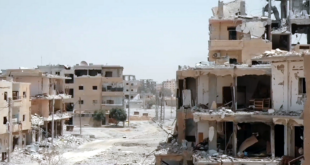Use the Kremlin’s Seized Assets to Pay for Reconstruction
The world’s attention has understandably been focused on the military side of the war in Ukraine. But in the next stage, the political-economic strategy may be decisive. As Tacitus once wrote of the Roman strategy in Britain, “they make a desolation and they call it peace.” Russia aims to do this to Ukraine not only with missile strikes and atrocities against civilians, but also by destroying the country’s economy. Its goal is not just Ukraine’s physical destruction, it is also to grind down the country’s hopes.
So far, Russia has successfully and severely damaged Ukraine’s economic prospects. It has shut down maritime shipping—the main way the country usually exports goods—with a naval blockade. A large fraction of Ukraine’s people have already become refugees or are otherwise displaced from their homes and businesses. Ukraine’s overall economy has suffered a massive blow, and the World Bank estimates that it will shrink by 45 percent this year (although the magnitude will depend on the duration and intensity of the war).
The coalition of countries helping Ukraine, centered in the G-7 and the European Union, must therefore prepare a countering strategy. The centerpiece of it should be a bold plan to rebuild Ukraine, better than before. The expenses will be substantial: in addition to military assistance, such an effort will cost at least $500 billion, and aid will need to start flowing this month. As was the case with Marshall Plan assistance, most of this money must come in grants, not loans. Both the World Bank and the International Monetary Fund can provide technical help, but such a plan will quickly outstrip their existing capabilities. Ukraine’s allies will need new mechanisms.
A core potential source of funds: the Russian assets currently frozen by G-7 and EU governments, as well as Switzerland. That may seem like a dramatic proposal. But this is completely consistent with international norms and rules. In fact, Russia will need to rush to negotiate if it wants to limit its losses exclusively to already frozen funds. The coalition should also tightly link massive reconstruction with Ukraine’s accession to the European Union, an institution that can help it overcome past governance challenges and better adapt its economy to the future.
JUST COMPENSATION
Experts are already designing an ambitious strategy for Ukraine’s renewal. Assembled by Beatrice Weder di Mauro of the Centre for Economic Policy Research in London, a team of economists recently released “A Blueprint for the Reconstruction of Ukraine,” a proposal informed by historical lessons from past giant rebuilding efforts, including the Marshall Plan. (One of us, Simon Johnson, contributed.) The strategy envisions three stages of reconstruction: first, an emergency response; second, a campaign to rapidly restore critical infrastructure and services to revive basic functions of the economy and government; and finally, putting the country on a fast, sustained trajectory for growth and modernization.
The aid should be quick but conditional, with terms that make sure the assistance is well spent and that Ukraine makes further progress in fighting corruption. The aid should help Ukraine align its regulatory and legal environment to EU standards, promote trade, and attract foreign direct investment. The sources and uses of funding must be closely coordinated with donors and recipients to minimize waste and delays. This will require a new, freestanding EU-related agency, inspired by the Economic Cooperation Administration that managed Marshall Plan aid.
The EU is already creating an institution—the Ukraine Solidarity Trust Fund—to “facilitate massive investment to restore the country’s economy and infrastructure,” as European Council President Charles Michel put it. The fund can also disburse money that will empower the government of Ukraine in other ways, including in Kyiv’s effort to dole out funds in response to individual claims of damage from Russia. It can also disburse money to other affected countries, such as Poland, which is taking care of a large number of refugees. But Ukraine is the main object, and solidarity fund money should be spent in a way that’s consistent with the country’s interests and focused on its national institutions. The fund must offer direct budget support to Ukraine as needed, and it should spend in line with best practices of EU transparency.
The costs of rebuilding Ukraine will be enormous, but not without precedent.
One critical way to help make sure that Ukraine’s governance meets EU standards is by putting it on a trajectory to becoming a member. Visiting Kyiv on April 8, the president of the European Commission, Ursula von der Leyen, said that the next stage of the EU process “will not as usual be a matter of years” but instead “a matter of weeks.” Ukraine has already been connected to the European electricity grid, and the country is indeed on track to receive EU accession candidate status at a June meeting of the European Council. “Russia will descend into economic, financial, and technological decay, while Ukraine is marching towards the European future,” von der Leyen announced. “This is what I see.”
The EU-affiliated fund or agency can make multi-year investment plans, including a strategy to sunset when Ukraine joins the EU in order to avoid creating a permanent bureaucracy with perverse incentives. To help ensure that Ukraine has a sense of ownership in the reconstruction process, the new fund can use matching funds from Ukrainian sources. It can make its decisions in partnership with Kyiv while also involving local Ukrainian governments, fostering decentralization. The fund must align its investment plans with those developed by the country.
Although the costs will be enormous, they are not without precedent. U.S. spending on the Marshall Plan, if scaled to the current size of the U.S. economy, was more than $900 billion. The unification of Germany cost more than $2 trillion, including about $330 billion to upgrade the infrastructure of East Germany. And there’s a clear and appropriate funding source for much of the $500 billion: the euros, dollars, and yen that the G-7 and EU governments, plus Switzerland and others, have frozen in Russian central bank and other state-related accounts. These assets may already total more than $300 billion, and they should be deployed as compensation for the damage caused by Russian aggression.
The West must deploy a strategy of hope if it wants to counter Russia’s strategy of despair.
This approach conforms with widely accepted principles of international law. There is no serious dispute that the Russian invasion of Ukraine is a wrongful, unprovoked war of aggression that violates the United Nations Charter. That conclusion has been supported by a March 2022 ruling of the International Court of Justice, which is binding under the charter. It was also the conclusion adopted in an overwhelming March vote of the UN General Assembly. Russia is therefore legally obliged to compensate Ukraine. (Belarus, which has served as a staging ground for Russian forces, may share this responsibility as well.)
Under international law, Ukraine can now formally give Russia its claim for compensation or reparations, as can other states damaged by Russia’s war. All states are also allowed to invoke Russia’s responsibility to compensate Ukraine, and they can take countermeasures against Moscow—including transferring its frozen foreign assets to ensure Ukraine gets paid. This is not a process that involves private lawsuits or new court decisions. It is a process of direct state action, with governments imposing some of the costs that they warned the Russian government would happen if it invaded.
There are precedents for such transfers, including as recently as this year. After the Taliban conquered Afghanistan, the United States froze the country’s central bank assets. Earlier this year, the U.S. government ordered at least half of these funds—$3.5 billion—transferred to humanitarian efforts that can help alleviate the Afghan people’s suffering. Under U.S. law, President Joe Biden could similarly authorize a transfer of Russian assets under section 1702 of the International Emergency Economic Powers Act. (Biden has already made the requisite emergency declaration.) Other relevant governments have analogous authorities, which they have already used to freeze Russian assets.
LOW RISK, HIGH REWARD
Some Western officials may want to refrain from transferring Russian assets right now, either because they are uneasy about the precedent it may set or because they want to keep it in the escalatory toolbox. But states have already crossed the Rubicon with their massive freezing of Russia’s funds. Firms or governments managing foreign exchange accounts are already incorporating these political risks into their calculations. And as long as the dollar and the euro remain politically coordinated—linked politically and with swap lines to other currencies—asset holders will continue to rely on dollar or euro accounts.
Transferring frozen Russian funds as compensation also doesn’t foreclose diplomacy. Russia has likely already written off the frozen assets as gone, but it still has an incentive to negotiate because it has more gigantic assets that remain at risk. In the rest of 2022, Russia is on track to earn $200 billion to $300 billion (or more) from energy sales. These earnings will mostly be in euros and dollars, deposited in banks that mainly operate in Europe and the United States. Those accounts are still exempt from sanctions, but that could change, and soon. The jurisdictions that regulate those euro and dollar holdings could turn them into escrow accounts, with spending allowed only for approved, nonmilitary purposes. And over time, states and private actors could more aggressively target these and other Russian assets, including Russia’s commercial ships and oil cargoes. If it wants to prevent hundreds of billions of dollars in further losses, Russia will need plenty of diplomacy.
But even if reappropriating Russian assets did make diplomacy more difficult, the coalition would still need to do it. Ukraine’s economy and society are at risk of disintegrating, and the West must soon deploy a strategy of hope if it wants to counter Russia’s strategy of despair. Only a joint effort on an epic scale can do that, one that displays positive resolve comparable to the destructive impulse animating Moscow’s war. It is also difficult to think of any better scenario for eventually disposing of Russia’s frozen assets. Returning them to Russian President Vladimir Putin seems unlikely and unwise, and Western publics are unlikely to support funding Ukraine’s reconstruction so long as Russia’s assets are not utilized.
Indeed, transferring these funds may be the most critical economic action that the G-7 and EU can take. Right now, the West’s economic debate is centered on whether and how to stop purchasing Russian oil and gas. But although that is important, a positive strategy toward Ukraine is more significant and urgent. Millions of Ukrainians have fought for and earned their chance to dream of a brighter future. Their friends should now bring that dream within reach.
 Eurasia Press & News
Eurasia Press & News




